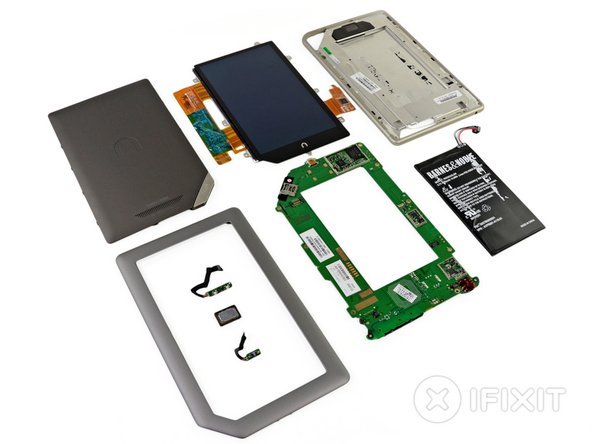
But instead of cutting into tension — which we’re pretty sure wasn’t physically possible — we focused on carving into every cranny of the new Nook, which we’ve found to share a lot in common with its fiery foe.
Not going to lie: the Nook Tablet was a tad tricky to get into. Anyone wanting to embark on this adventure will need to gear up with both metal and plastic spudgers, plastic opening tools, a Torx T5 screwdriver, and an extra ounce of patience.
Loads of adhesive, a fair number of screws, and a perplexing internal design guarantees some frustrating situations. Even though the Nook Tablet is almost as simple feature-wise as the Fire, it turned out to be much more difficult to get into; so a middle-of-the-road 6 out of 10 repairability score was definitely appropriate.
Teardown highlights:
- The Nook has its microSD slot stashed away under a magnetic cover next to the carabiner clip. This could make changing your SD card while rock climbing a bit difficult if you’re using the Nook as a tie point.
- The two small circles flanking the microSD slot may look like harmless aesthetic pieces, or even buttons, but they actually house insidious screws that will hamper your disassembly efforts.
- Just as we thought, the rounded sides of the Nook are deceptive. Even though it looks skinnier than the Fire, it’s actually a hair pudgier. The Fire measures in at .45″, but the Nook is .03 inches thicker, at a mind-blowing .48″! Holy smokes!
- The Nook’s 1 GB of RAM easily conquers its rivals’ (Fire and iPad 2) 512 MB offerings, but we feel that’s a pretty small victory — more RAM does not necessarily translate to more performance.
- The 3.7 V, 4000 mAh battery provides an advertised 11.5 hours of use time, which easily beats the Kindle Fire’s 8 hours.
- A little wiggling and out comes the motherboard. Let’s see who we’re dealing with:
- SanDisk SDIN5C1-16G 16 GB Flash Memory
- Texas Instruments 6030B107 Fully Integrated Power Management IC
- Texas Instruments AIC3100 Low-Power Audio Codec With 1.3 W Stereo Class-D Speaker Amplifier
- Texas Instruments LVDS83B FlatLink 10-135 MHz Transmitter
- Hynix H9TKNNN8P 1 GB DDR2 RAM
- The Hynix chip likely covers the Texas Instruments OMAP4 1 GHz dual-core processor, just like in the Kindle Fire.
- A closer look at one of the ribbon cables reveals a FocalTech FT5406EE8 Capacitive Touch Panel Controller.
- Ready for more shocking similarities to the Kindle Fire? The Nook Tablet’s 7″ IPS display also runs at a resolution of 1024 x 600 pixels and produces the same 16 million colors. Unreal!





댓글 0개